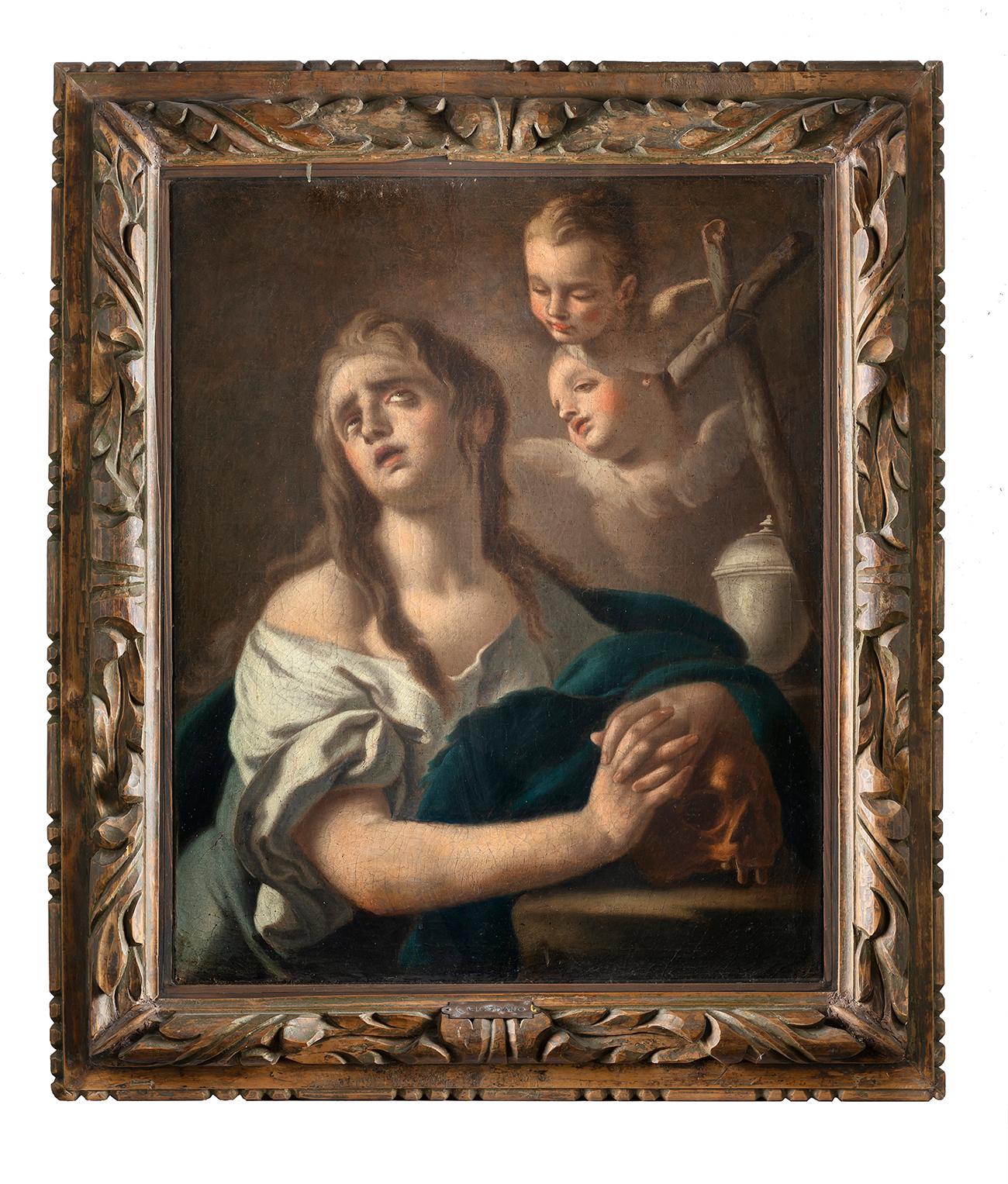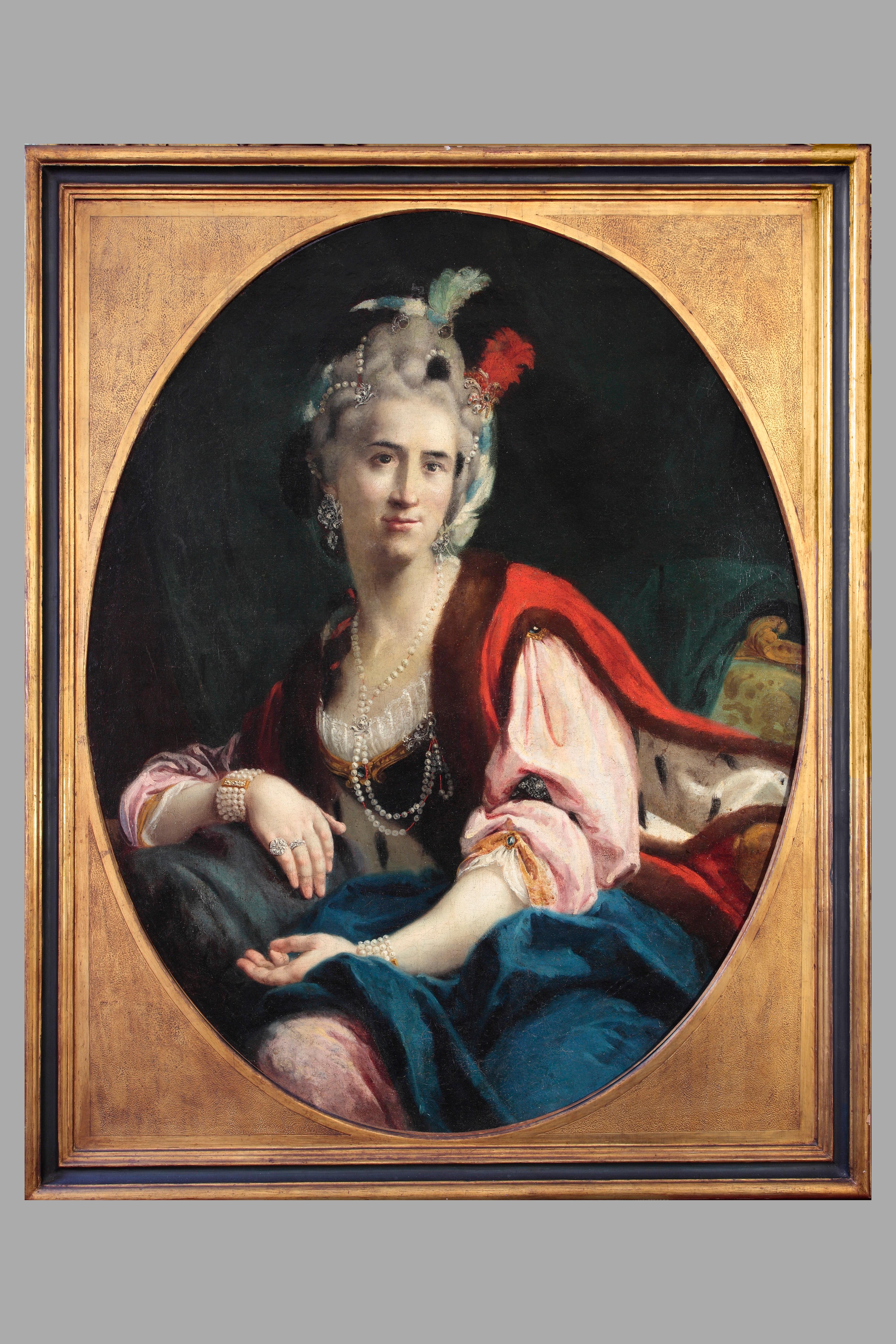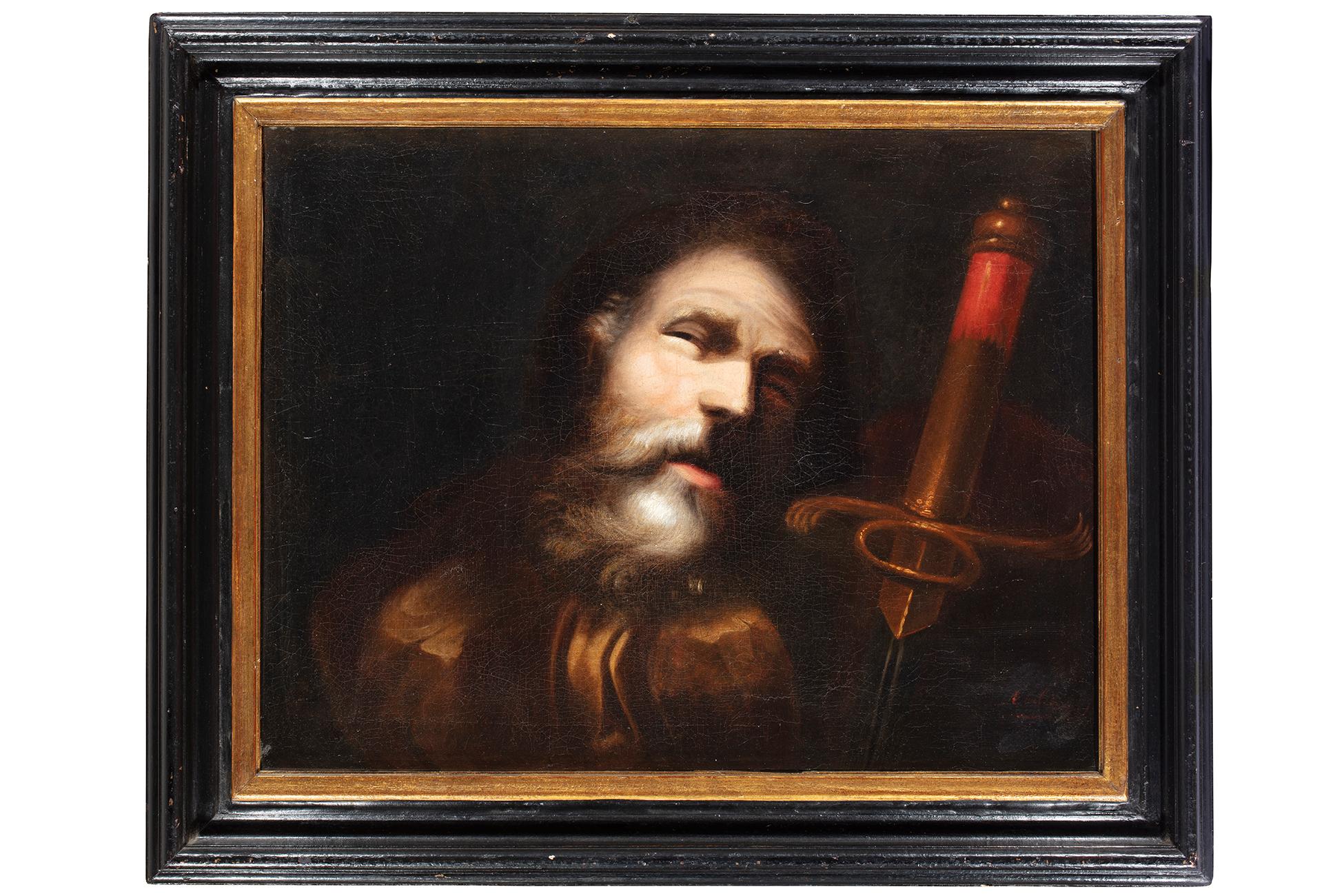Items Similar to Early 18th century portrait painting of Henrietta Paulet, Duchess of Bolton
Want more images or videos?
Request additional images or videos from the seller
1 of 9
Early 18th century portrait painting of Henrietta Paulet, Duchess of Bolton
About the Item
Portrait of Henrietta Paulet, Duchess of Bolton, née Crofts, (c. 1682–1730), three-quarter length, standing on a colonnaded terrace wearing an ivory silk gown and holding a sprig of orange blossom, an Italianate country house and garden in the background.
Oil on canvas, inscribed "Duchess of Bolton 1720" to the verso, housed in a magnificent English period 'Sunderland' frame.
Canvas: 125 x 102cm (49 1/2 x 40 in.)
Henrietta was the eldest daughter of James Scott, 1st Duke of Monmouth (who was the illegitimate son of King Charles II), and Eleanor Needham. Henrietta took the surname of “Crofts” that had been assumed by her father when he was in the care of the Crofts baronets. Her mother’s sister, Jane Myddelton, was one of the celebrated Windsor Beauties. Henrietta became the third wife of Charles Paulet, 2nd Duke of Bolton in Dublin in about 1697, some years after the death of his second wife, Frances.
From 1714 to 1717, the duchess was a Lady of the Bedchamber to the Princess of Wales, Caroline of Ansbach.She was one of the aristocratic female signatories to Thomas Coram’s petition to establish the Foundling Hospital in London, which was presented to King George II in 1735. She signed the petition on 25 April 1729, and Gillian Wagner suggests that the Bolton family members may have signed as a result of their ‘personal experience of illegitimacy in the(ir) family’.
Charles and Henrietta had one son, Lord Nassau.
Maria Verelst (1680-1744) was born in Vienna, moving to London aged three with her father, the artist Herman Verelst (1641-1690) where she became his pupil. She started painting portraits professionally at age fourteen and went on to work alongside other well-known artists including Charles Jervas, William Aikman and John Thornhill. Her portraits were in the similar fashionable 18th style as Godfrey Kneller and Michael Dahl and much of her work remains misattributed to these and other male artists from the period.
There are particular stylistic techniques that Maria liked to use, such as more pronounced and brighter highlights in clothes and drapery and the care she took in placing her sitters within an interesting architectural or garden setting.
Maria was well educated and spoke a number of different languages which no doubt helped her secure patronage. According to an anecdote published in 1730 Maria was once at Drury Lane theatre when she heard some gentlemen nearby praising her in German, she then turned to them and began conversing in the same language before the gentleman switched to Latin, Maria proceeded in Latin and the gentlemen were so impressed that they commissioned their portraits, and through their connections Maria supposedly built up her list of clientele.
- Attributed to:Maria Verelst (1680 - 1744, English)
- Dimensions:Height: 50 in (127 cm)Width: 40 in (101.6 cm)
- Medium:
- Movement & Style:
- Period:
- Condition:
- Gallery Location:Bath, GB
- Reference Number:1stDibs: LU95214221272
About the Seller
5.0
Vetted Seller
These experienced sellers undergo a comprehensive evaluation by our team of in-house experts.
Established in 2002
1stDibs seller since 2015
36 sales on 1stDibs
Typical response time: 1 hour
Associations
The British Antique Dealers' AssociationLAPADA - The Association of Arts & Antiques DealersInternational Confederation of Art and Antique Dealers' Associations
- ShippingRetrieving quote...Ships From: Bath, United Kingdom
- Return PolicyA return for this item may be initiated within 3 days of delivery.
More From This SellerView All
- English 17th century portrait of James Thynne as a young boy by a fountainBy Johann KerseboomLocated in Bath, SomersetPortrait of the Hon. James Thynne (c. 1680-1704), full-length, in the gardens of Longleat House, seated beside a fountain, holding a shell beneath water spouting from a horn blown by a cherub on a dolphin. A glimpse of part of Longleat House can be seen upper left. Oil on canvas in a period giltwood frame, decorated with leaves and acorns. C. 1682. Dimensions: 145 x 123cm (57 x 48in) in frame Provenance: Ex Longleat House, Wiltshire Private collection, Bath James Thynne was the youngest son of Thomas Thynne, 1st Viscount Weymouth and Frances Finch of Longleat House, Wiltshire. He died in his youth and his Aunt, Anne Kingsmill Finch, Countess of Winchilsea (1661-1720), wrote a moving poem on his death. He was buried in the family vault at Longbridge Deverill, Wiltshire. A mezzotint of this painting by William Faithorne the Younger is held in the Royal Collection. Johann Kerseboom (d.1708) was the nephew of Frederick Kerseboom and first worked in Germany before coming to England in the 1680's where his sitters included the 'Electress Sophia Dorothea' (known from a mezzotint by William Faithorne). His early works were influenced by William Wissing...Category
17th Century Old Masters Portrait Paintings
MaterialsOil, Canvas
- Attributed to John Riley, 17th century English portrait of a girl on a terraceBy John RileyLocated in Bath, SomersetPortrait of a young girl, full-length, wearing a blue silk gown, standing on a terrace beside a classical urn holding a branch with blossom. Attributed to John Riley...Category
17th Century Old Masters Portrait Paintings
MaterialsOil, Canvas
- English 18th century portrait of Henrietta Pelham-Holles, Duchess of Newcastle.By Charles JervasLocated in Bath, SomersetPortrait of Henrietta Pelham-Holles (née Godolphin) (1701-1776), Duchess of Newcastle, standing in a wooded landscape with a river beyond, three-quarter length wearing an ivory silk ...Category
1720s Old Masters Portrait Paintings
MaterialsOil, Canvas
- 18th century English portrait of a lady beside an urn, with a basket of flowersBy Tilly KettleLocated in Bath, SomersetPortrait of a lady wearing a white gown with a red cloak, pearls in her hair and draped over one shoullder, standing beside a classical urn with a basket of flowers, c.1765. The portrait is believed to be a companion portrait of a John (1741-1816) or James (1751-1807) Durno which is housed in an identical frame. The sitter is possibly either the wife of John who was Janes Byres of Stonywood or John and James's sister Elizabeth. (James never married). The Durno family were based around the Aberdeen area of Scotland and John was an advocate in the area and then later a customs official in Jamaica. James was a successful timber merchant, spending time in the Baltic before being made His Majesty's Consul in Memel, Prussia. The portrait is likely to have been painted before Tilly travelled to India in 1768, when John, Jane and Elizabeth would have been in their twenties. We are gtrateful to Mark Beattie for sharing his family knowlege and research on the portrait. Provenance: With W. C. Beattie in the mid 19th century, and by descent through the family Private collection, Kent With thanks to Hugh Belsey who has confirmed this to be the work of Tilly Kettle from photographs. Tilly Kettle (1735-1786) was born in London, the third of six children by Henry Kettle (c.1704-c.1773), a coach painter, and his wife Ann. He attended William Shipley...Category
18th Century Old Masters Portrait Paintings
MaterialsCanvas, Oil
- 17th century portrait of a ladyBy Nicolaes MaesLocated in Bath, SomersetPortrait of a lady by Dutch Golden Age painter Nicolaes Maes (1634-1693). Half-length, within a feigned oval, the lady wears a pearl necklace and earrings, an ivory silk gown adorned...Category
17th Century Old Masters Portrait Paintings
MaterialsCanvas, Oil
- A portrait of a lady and her daughter with an exotic birdBy Michael DahlLocated in Bath, SomersetA portrait of a lady three-quarter length, seated in an interior, wearing a red silk gown draped in a pink silk sash with an exotic bird perched on her hand and one arm resting on a stone plinth, her young daughter wearing a green silk gown standing at her side. Oil on canvas, housed in a period 'Lely' giltwood frame. This double portrait was painted at the height of Dahl's career in circa 1715 when Dahl had become firmly established as one of the leading portrait painters in Britain. Although the identities of the sitters are currently unknown, it is a sensitive depiction of a close and affectionate bond between a mother and daughter, with the young girl's hand resting affectionately on her mothers lap. The tamed exotic bird adds a charming decorative element which also serves to convey the high social status of the lady, given only the very wealthy would be able to own such a rare and expensive pet and the lively colouring of the bird's feathers is reflected in the colours of the sitters' silk gowns. Provenance: Private collection, London Michael Dahl (Stockholm 1659-1743 London) was born in Stockholm in Sweden and studied under Martin Hannibal (d 1741) and later with David Klöcker Ehrenstrahl. In 1682 he travelled to London, where he became acquainted with Godfrey Kneller and Henry Tilson, and in 1685 he left for Europe with Tilson, working briefly in Paris before continuing to Venice and Rome, where they stayed for about two years. In Rome Dahl converted to Roman Catholicism and gravitated towards the circle of Christina, former Queen of Sweden, who sat for him (Grimsthorpe Castle, Lincs). He returned to England with Tilson via Frankfurt and arrived in London in 1689, staying in England for the remainder of his career. During Dahl's absence, Kneller had consolidated his supremacy in London as the most fashionable portrait painter, but Dahl rapidly became Kneller’s closest competitor. His patrons probably had roots in the Swedish diplomatic circles, but it expanded as a result of his ability and his agreeable personality. His prices were lower than those of Kneller and he favoured softer, more diffused, colour tones and could respond to his sitters with sincerity and humanity. Politically, Kneller supported the ascendant Whigs while Dahl was a Tory, but they frequently painted the same sitters from both parties, and in spite of fundamental differences in technique and temperament, their work was sometimes similar in appearance. Dahl was prolific but rarely signed his work, and comparatively few of his portraits were engraved in mezzotint, the method used by Kneller to widen his reputation. By 1690 he had painted the aged Duke of Schomberg (engraved by William Faithorne) and Prince George of Denmark (London, Kensington Palace). He was ignored by William III but received commissions from Princess Anne, including one for a portrait of herself (Oakly Park, Ludlow, Salop). He also painted the future Duke and Duchess of Marlborough, and his informal portrait of the Duchess (Althorp House, Northants), formerly attributed to Kneller, is perhaps the most intimate of all images of her. During the 1690s he secured the patronage of Charles Seymour, the ‘Proud’ 6th Duke of Somerset, who ordered a series of seven full-length portraits of notable contemporary beauties from Dahl (1690s; Petworth House, W. Sussex, NT). This was originally a scheme similar to Kneller’s more famous ‘Hampton Court Beauties’, but the portraits were subsequently reduced to three-quarter-length formats. The features of the sitters are not individualized, but they possess a decorative, languorous glamour that recalls Lely rather than Kneller. Somerset gave Dahl further employment over the next 25 years. In 1698, following the death of Klöcker Ehrenstrahl, Dahl was offered the post of court painter at Stockholm, which he apparently refused, preferring to remain in London at his studio in Leicester Fields, near the Swedish legation. In about 1700 he was joined by a young compatriot, Hans Hysing, who worked with him for many years. Dahl seems not to have married until after 1708, He had a son Michael (d. 1741), also a painter, of whose work nothing is known, and two daughters. After the accession of Queen Anne in 1701, she and Prince George sat for a number of official portraits. His royal patronage ceased with Queen Anne’s death, and when Dahl refused to paint the infant Duke of Cumberland in 1722. He was suspected of Jacobite sympathies, and relations had cooled between him and the Swedish legation. However, his practice continued to prosper, and he acquired another important patron in Edward Harley, 2nd Earl of Oxford, who shared his political views and whose circle included the architect James Gibbs and the poets Matthew Prior and Alexander Pope, all of whom Dahl painted. Oxford commissioned several portraits of himself. In the earliest (1719; Welbeck Abbey...Category
Early 18th Century Old Masters Portrait Paintings
MaterialsCanvas, Oil
You May Also Like
- Oil Painting Portrait, attributed to John Vanderbank (1694-1739)By John VanderbankLocated in Uppingham, GBOil Painting Portrait of John Campbell, 4th Duke of Argyll,, att to John Vanderbank (1694-1739) Housed in a swept frame which has been restored after photo. Canvas Size 50" x 40", Fr...Category
1690s Old Masters Portrait Paintings
MaterialsCanvas, Oil
- 18th Century by Pietro Bardellino Mary Magdalene Painting Oil on CanvasBy Pietro BardellinoLocated in Milano, LombardiaPietro Bardellino (Naples, 1731 – Naples, 1806) Mary Magdalene Oil on canvas, cm. 75 x 60 – with frame cm. 97 x 82 Antique shaped and carved wooden frame Publications: unpublished T...Category
Mid-18th Century Old Masters Portrait Paintings
MaterialsCanvas, Oil
- 18th Century By Dalla Rosa Portrait of Angela GuggerottiFracastoro Oil on CanvasLocated in Milano, LombardiaFrame in lacquered and gilded wood. The painting is mentioned in Dizionario Biografico degli Italiani Treccani in the biography of the artist.Category
18th Century Old Masters Portrait Paintings
MaterialsCanvas, Oil
- 17th Century by Giuseppe Assereto Portrait of an Elderly Woman Oil on CanvasBy Giuseppe AsseretoLocated in Milano, LombardiaGiuseppe Assereto (Genova - 1626 ca – Genova 1656/57) Portrait of an elderly woman, possible portrait of Maddalena Massone, wife of Gioacchino Assereto Oil on canvas, cm. 65,5 x 51,5...Category
Early 17th Century Old Masters Portrait Paintings
MaterialsCanvas, Oil
- 19th Century By Giuseppe Molteni Portrait of a Woman Oil on CanvasLocated in Milano, LombardiaBeautiful original frame in gilded wood. Expertise by Prof. Fernando Mazzocca.Category
19th Century Old Masters Portrait Paintings
MaterialsCanvas, Oil
- 17th Century by Juan Alfonso Abril Head of St Paul Painting Oil on CanvasLocated in Milano, LombardiaJuan Alfonso Abril (active in the 17th century in Valladolid) Head of Saint Paul Oil on canvas, cm. 48,5 x 62 - with frame cm. 63 x 76,5 Shaped wooden f...Category
Early 17th Century Old Masters Figurative Paintings
MaterialsCanvas, Oil





